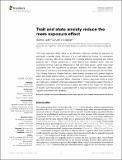Trait and state anxiety reduce the mere exposure effect
Author(s)
Gabrieli, John D. E.; Ladd, Sandra
DownloadLadd-2015-Trait and state anxi.pdf (410.2Kb)
PUBLISHER_CC
Publisher with Creative Commons License
Creative Commons Attribution
Terms of use
Metadata
Show full item recordAbstract
The mere exposure effect refers to an affective preference elicited by exposure to previously unfamiliar items. Although it is a well-established finding, its mechanism remains uncertain, with some positing that it reflects affective processes and others positing that it reflects perceptual or motor fluency with repeated items. Here we examined whether individual differences in trait and state anxiety, which have been associated with the experience of emotion, influence the mere exposure effect. Participants’ trait (Study 1) and state (Study 2) anxiety were characterized with the State-Trait Anxiety Inventory. Greater trait and state anxiety correlated with greater negative affect and lesser positive affect. In both experiments, greater anxiety was associated with a reduced mere exposure effect. Measures of fluency (response times at study and test) were unrelated to the mere exposure effect. These findings support the role of affective processes in the mere exposure effect, and offer a new insight into the nature of anxiety such that anxiety is associated with a reduced experience of positive affect typically associated with familiarity.
Date issued
2015-05Department
Massachusetts Institute of Technology. Department of Brain and Cognitive Sciences; McGovern Institute for Brain Research at MITJournal
Frontiers in Psychology
Publisher
Frontiers Research Foundation
Citation
Ladd, Sandra L., and John D. E. Gabrieli. “Trait and State Anxiety Reduce the Mere Exposure Effect.” Front. Psychol. 6 (May 28, 2015).
Version: Final published version
ISSN
1664-1078